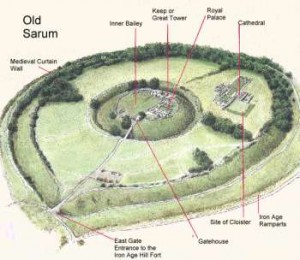Archaeologists expose lost medieval palace under prehistoric fortress at Old Sarum
The archaeological site of Old Serum situated in Wiltshire, England, has a rich history stretching back at least five thousand years. But it was William the Conqueror’s collection of the site for his royal castle in the 11th century that left the greatest mark on this historic landmark.
Now geophysical surveys have uncovered that what lies beneath the surface may actually be one of the major medieval royal palaces ever found, built within the grounds of a vast Iron Age fortress, and hidden beneath fields for more than 700 years.
The high-tech scans carried out by archaeologists from the University of Southampton, including magnetometers, earth resistance, ground penetrating radar, and electric resistivity tomography survey, have exposed the foundations of dozens of houses and an enormous, previously unknown complex, measuring 558 ft long and 14 ft wide, which is believed to have been a royal palace.
“The main applicant for constructing it is perhaps Henry I sometime in the early 12th century,” said one of Britain’s foremost experts on high rank medieval buildings, Dr Edward Impey, Director-General of the Royal Armouries.
The complex was set about a large courtyard with 3 m wide walls, and included a long building, which was maybe a grand hall. There is also proof of towers and multi-storey buildings. If it is indeed a medieval royal palace, it is the largest of its kind ever found in Britain. Up until now, archaeologists were only conscious of the much smaller complex on top of the man-made castle mound.
Old Sarum was initially an Iron Age hill fort, built in 400 BC on a site that had been inhabited since at least 3,000 BC. The site was used by the Romans, attractive town of Sorviodunum. The Saxons also used the site as a stronghold against marauding Vikings.
In the 11th century, William the Conqueror, having gained in charge of of England, chose Sarum as the site for a royal castle. The fact that it lay within a large hill fort meant that defenses could be constructed quickly. The castle was built on a motte protected by a deep dry moat in 1069, three years after the Norman Conquest. The formation of a cathedral and bishop’s palace occurred between 1075 and 1092.
A royal palace was then built within the castle for King Henry I and presently used by Plantagenet monarchs.
By 1219, the limits of freedom on the hilltop site had become reason for concern, with the cathedral and castle in close immediacy and their own chiefs in regular clash. The rejection of Old Sarum by the clergy during the 1220s marked the end of serious royal interest in the castle. The castle continued in use, but was mainly abandoned by the 16th century.
The new research has enabled archaeologists to piece together the layout of the old medieval city, shedding new light on the urban preparation of a Norman city. While the significance of Old Sarum has been known about for some time, only now are archaeologists beginning to piece mutually the long-vanished city buried under the green fields that thousands of tourists visit every year.
